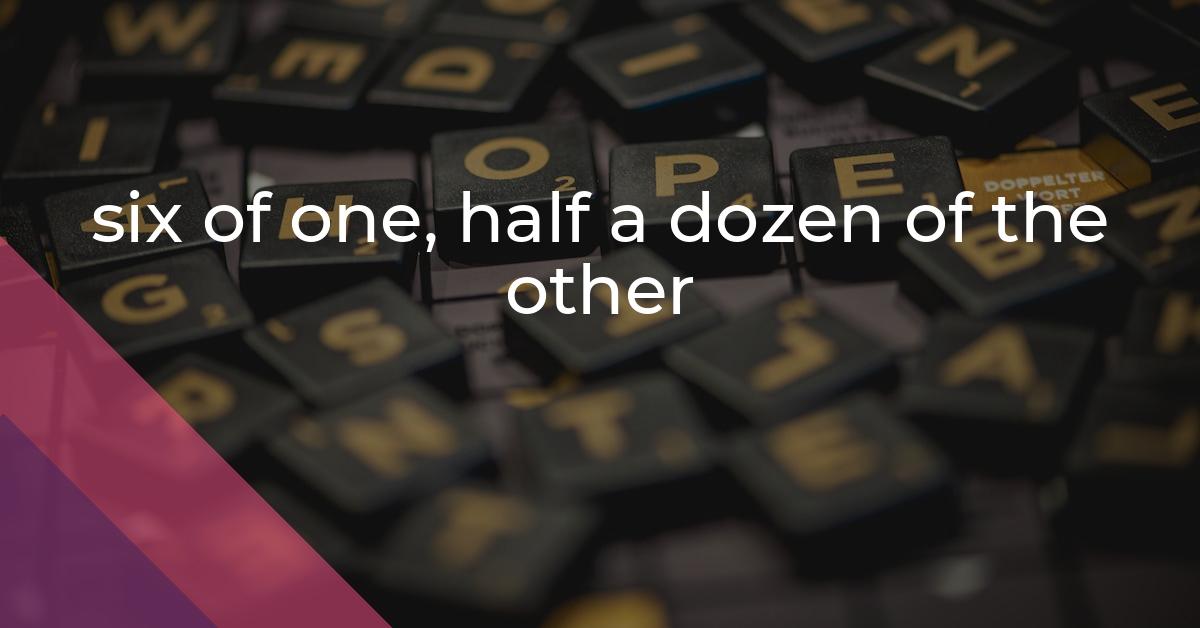six of one, half a dozen of the other: Idiom Meaning and Origin
What does ‘six of one, half a dozen of the other’ mean?
The idiom "six of one, half a dozen of the other" means that two choices or options are essentially the same in outcome or value.

Idiom Explorer
The idiom "two sides of the same coin" means that two things appear different, but are actually closely related or connected.
The idiom "the half of it" means that something is incomplete or lacking important information. It suggests that there is more to a situation than what is currently known or stated.
The idiom "ten to one" means there is a high probability or likelihood of something happening. It suggests that the chances of a particular outcome are very likely, with the ratio being 10:1 in favor of that outcome.
The idiom "take sides" means to choose or support one person, group, or opinion over another, often in a conflict or disagreement.
An idiom meaning that one has to accept a situation or offer as it is, without the possibility of negotiation or change.
The idiom "summer and winter" refers to the two extreme seasons that represent opposite conditions or moods. It is often used metaphorically to describe a stark contrast or a wide range of differences between two things or situations.
The idiom "sixth-rate" refers to something of very poor or low-quality, ranking below the average standard. It is often used to describe a person, object, or situation that is considered to be inferior or subpar.
The idiom "six of the best" refers to a punishment or beating with a cane or whip. The phrase implies that the punishment was harsh or severe.
Numerical Equivalence: A Deceptive Dilemma
The idiom "six of one, half a dozen of the other" is a commonly used expression in the English language. It is often employed to highlight situations where two alternatives or options are considered to be equivalent or equal in value, despite having different names or presentations. The phrase is generally used to convey a sense of indifference or a lack of preference between the options being discussed. This idiom is related to several other idioms, such as "six and two threes," "go halfsies," "two sides of the same coin," "baker's half dozen," and "go halves."
While the metaphorical meaning of the idiom is widely understood, its origin and history remain shrouded in mystery. Several theories have been put forth, but none can be definitively confirmed.
One possible explanation for the idiom's origin points to the fact that both "six" and "half a dozen" refer to the exact same quantity, specifically six. The idiom "six of one, half a dozen of the other" highlights the redundancy of naming the quantity in two different ways, emphasizing that they are essentially the same thing. This theory suggests that the idiom developed as a way to highlight the arbitrary nature of assigning different names to identical objects or concepts.
Another related idiom, "six and two threes," is often used interchangeably with "six of one, half a dozen of the other." It conveys the same idea that two options are essentially the same and that there is no significant difference between them. The phrase "six and two threes" further emphasizes the numerical equivalence between the options.
Another theory proposes that the idiom may have evolved from the concept of buying or selling goods. In a transaction, a seller may present a customer with the option of purchasing six individual items for a certain price, while another seller might offer half a dozen of the same items for the same price. The idiom "six of one, half a dozen of the other" could have originated as a way to acknowledge that, regardless of the presentation, the customer would still be obtaining the same quantity of items.
Similarly, the idiom "go halfsies" also relates to the concept of sharing or dividing something equally. It implies that the two parties involved will each contribute or receive an equal share or portion. This idiom further emphasizes the idea of equivalence and fairness in a situation where two options or portions are being divided equally.
Furthermore, the idiom "two sides of the same coin" is another related expression that highlights the equality or similarity between two seemingly different options or perspectives. It suggests that although the options may appear different on the surface, they are fundamentally connected or interrelated. This idiom serves to emphasize the idea that the options are not as distinct as they may initially seem, reinforcing the notion of equivalence.
The idiom "baker's half dozen" is yet another related expression that conveys the concept of equivalence through numerical comparison. A baker's half dozen refers to a quantity of six, which is half of a full dozen of twelve. This idiom underscores the idea that six is an equivalent or comparable quantity to half of a dozen.
The expression "go halves" also relates to the idea of equality and equivalence. It suggests that two parties will equally share the responsibility, cost, or outcome of a situation or endeavor. This idiom further emphasizes the notion of balance and fairness, highlighting the equality between the options or contributions of each party involved.
It is worth noting that the idiom "six of one, half a dozen of the other" is not limited to any specific region or country, and it is used in both formal and informal contexts. Its simplicity and versatility make it readily accessible and applicable in a wide range of situations.
Despite the lack of concrete historical evidence, the idiom continues to be widely used by English speakers. Its longevity can be attributed to its effectiveness in succinctly conveying the notion of equivalence or indifference. Whether debating between two options or underscoring the futility of making a decision, the idiom "six of one, half a dozen of the other" remains a reliable phrase that captures the essence of equality and interchangeability.
While the idiom itself may seem straightforward, its implications open up avenues for philosophical reflection. It begs the question of whether there truly is any meaningful distinction between seemingly different choices. In a world of seemingly endless possibilities, the idiom reminds us of the potential futility of deliberating too long on choices that ultimately yield the same outcome.
Perhaps the enduring appeal of this idiom lies in its ability to encapsulate a universal truth about the human condition - that even when faced with seemingly distinct options, the ultimate result may be more similar than we initially perceive. It reminds us to consider the bigger picture, the underlying essence, and the commonalities that bind seemingly disparate choices together.
Example usage
1. "Should we take the highway or the back roads to get there?" "I think it's six of one, half a dozen of the other. They both take about the same amount of time."
2. "We can either eat at the restaurant downtown or order takeout. What do you prefer?" "It's really six of one, half a dozen of the other. We might as well save some money and eat at home."
3. "Do you want the red shirt or the blue shirt?" "Honestly, it's six of one, half a dozen of the other. They both look equally good on you."
More "Equivalent" idioms
We missed the mark - nothing found.



